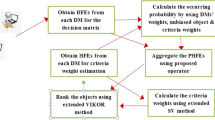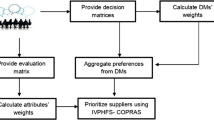Abstract
This paper introduces a new methodology for solving multi-attribute decision making (MADM) problems under hesitant fuzzy environment. The uncertainty in hesitant fuzzy elements (HFE) is derived by means of entropy. The resulting uncertainty is subsequently used in HFE to derive a single representative value (RV) of alternatives in each attribute. Our work transforms the RVs into their linguistic counterparts and then formulates a methodology for pairwise comparison of the alternatives via their linguistically defines RVs. The Eigen vector corresponding to maximum Eigen value of the pairwise comparison matrix prioritizes the alternatives in each attribute. The priority vectors of the alternatives are aggregated to derive the weights of the attributes using Quadratic programming. The weighted aggregation of the attribute values provides the ranking of the alternatives in MADM. An algorithm is written to validate the procedure developed. The proposed methodology is compared with similar existing methods, and the advantages of our method are presented. The robustness of our methodology is demonstrated through sensitivity analysis. To highlight the procedure, a car purchasing problem is illustrated.






Similar content being viewed by others
Data availability
Enquiries about data availability should be directed to the authors.
References
Alcantud JCR, de Andrés Calle R, Torrecillas MJM (2016) Hesitant fuzzy worth: an innovative ranking methodology for hesitant fuzzy subsets. Appl Soft Comput 38:232–243
Bozoki S, Fulop J (2018) Efficient weight vectors from pairwise comparison matrices. Eur J Oper Res 264:419–427
Chen S-M, Hong J-A (2014) Multicriteria linguistic decision making based on hesitant fuzzy linguistic term sets and the aggregation of fuzzy sets. Inf Sci 286:63–74
Cohon J (2004) Multiobjective programming and planning. Dover, Mineola
Crawford G, Williams C (1985) A note on the analysis of subjective judgement matrices. J Math Psychol 29:387–405
Gou X, Xu Z, Liao H (2017) Hesitant fuzzy linguistic entropy and cross-entropy measures and alternative queing method for multiple criteria decision making. Inf Sci 388–389:225–246
Herrera F, Martinez L (2000) An approach for combining linguistic and numeric information based on 2-tuple fuzzy linguistic representation model in decision-making. Internat J Uncertain Fuzziness Knowl-Based Syst 8(5):539–562
Herrera F, Herrera Viedma E, Martinez L (2000) A fusion approach for managing multi-granularity linguistic term sets in decision making. Fuzzy Sets Syst 114:43–58
Hu J, Yang Y, Zhang X, Chen X (2018) Similarity and entropy measures for hesitant fuzzy sets. Int Trans Oper Res 25:857–886
Jibin Lan RJ (2017) Priority degrees for hesitant fuzzy sets: application to multiple attribute decision making. Oper Res Prespect 4:67–73
Kaufmann A (1975) Introduction to the theory of fuzzy subsets, vol I. Academic, New York
Kosko B (1986) Fuzzy entropy and conditioning. Inf Sci 40:165–174
Li D, Zeng W, Li J (2015) New distance and similarity measures on hesitant fuzzy sets and their applications in multiple criteria decision making. Eng Appl Artif Intell 40:11–16
Liao H, Xu Z (2016) Hesitant fuzzy decision making methodologies and applications. Springer, Singapore
Liao H, Wu X, Liang X, Xu J, Herrera F (2018) A new hesitant fuzzy linguistic ORESTE method for hybrid multicriteria decision making. IEEE Trans Fuzzy Syst 26(6):3793–3807
Liao H, Gou X, Xu Z, Zeng X-J, Herrera F (2020) Hesitancy degree-based correlation measures for hesitant fuzzy linguistic term sets and their applications in multiple criteria decision making. Inf Sci 508:275–292
Peng J-J, Wang J-Q, Wu X-H (2016) Novel multi-criteria decision making approaches based on hesitant fuzzy sets and prospect theory. Int J Inf Technol Decis Mak 15(3):621–643
Qian G, Wang H, Feng X (2013) Generalized hesitant fuzzy sets and their application in decision support system. Knowl-Based Syst 37:357–365
Rao J, Tiwari R, Mohanty B (1988) A method for finding numerical compensation for fuzzy multicriteria decision problem. Fuzzy Sets Syst 25:33–41
Riera JV, Massanet S, Herrera-Viedma E, Torrens J (2015) Some interesting properties of the fuzzy linguistic model based on discrete fuzzy numbers to manage hesitant fuzzy linguistic information. Appl Soft Comput 36:383–391
Sellak H, Ouhbi B, Frikh B (2018) A knowledge based outranking approach for multi-criteria decision making with hesitant fuzzy linguistic term sets. Appl Soft Comput 67:625–640
Torra V (2010) Hesitant fuzzy sets. Int J Intell Syst 25(6):529–539
Wang Y-M, Parkan C (2005) Multiple attribute decision making based on fuzzy preference information on alternatives: ranking and weighting. Fuzzy Sets Syst 153:331–346
Wang J-Q, Wang J, Chen Q-H, Zhang H-Y, Chen X-H (2014) An outranking approach for multi-criteria decision-making with hesitant fuzzy linguistic term sets. Inf Sci 280:338–351
Wang J, Wang J-X, Zhang H-Y, Chen X-H (2015) Multi criteria decision making based on hesitant fuzzy linguistic term sets: an outranking approach. Knowl Based Syst 86:224–236
Wei C, Zhao N, Tang X (2014) Operators and comparisons of hesitant fuzzy linguistic term sets. IEEE Trans Fuzzy Syst 22(3):575–585
Xu Y, Da X, Liu L (2009) Normalizing rank aggregation method for priority of a fuzzy preference relation and its effectiveness. Int J Approx Reason 50:1287–1297
Xu Y, Wang H, Sun H, Yu D (2014) A distance based aggregation approach for group decision making with interval preference orderings. Comput Ind Eng 72:178–186
Yager RR (1995) Measures of entropy and fuzziness related to aggregation operators. Inf Sci 82:147–166
Yager RR (2003) Induced aggregation operators. Fuzzy Sets Syst 137:59–69
Yager RR (2004) Generalized OWA aggregation operators. Fuzzy Optim Decis Mak 3:93–107
Yang MS, Hussain Z (2019) Distance and similarity measures of hesitant fuzzy sets based on Hausdorff metric with applications to multi-criteria decision making and clustering. Soft Comput 23(14):5835–5848
Zimmermann H-J (1978) Fuzzy programming and linear programming with several objective functions. Fuzzy Sets Syst 1:45–55
Acknowledgements
We thank the anonymous reviewers for their valuable comments and suggestions by which our work is significantly improved.
Funding
The authors have not used any funding/grant to carry out this research work.
Author information
Authors and Affiliations
Corresponding author
Ethics declarations
Conflict of interest
All authors declare that they have no conflict of interest.
Additional information
Publisher's Note
Springer Nature remains neutral with regard to jurisdictional claims in published maps and institutional affiliations.
Rights and permissions
About this article
Cite this article
Mohanty, B.K., Aggarwal, E. A preference structure in multi-attribute decision making: an algorithmic approach based on hesitant fuzzy sets. Soft Comput 26, 7259–7277 (2022). https://doi.org/10.1007/s00500-022-07112-w
Accepted:
Published:
Issue Date:
DOI: https://doi.org/10.1007/s00500-022-07112-w




